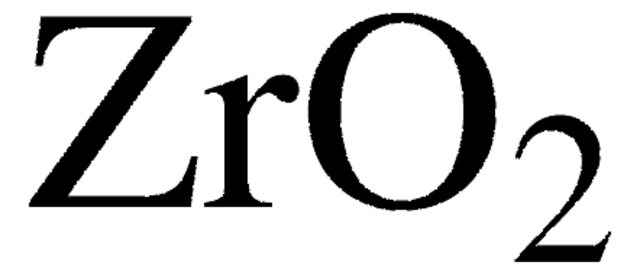About This Item
推荐产品
表单
powder
质量水平
反应适用性
reagent type: catalyst
core: zirconium
粒径
<10 μm
密度
5.52 g/mL at 25 °C (lit.)
SMILES字符串
[Ba++].[O-][Zr]([O-])=O
InChI
1S/Ba.3O.Zr/q+2;;2*-1;
InChI key
DQBAOWPVHRWLJC-UHFFFAOYSA-N
正在寻找类似产品? 访问 产品对比指南
一般描述
应用
- Interface Diffusion and Compatibility of (Ba,La)FeO(3-δ) Perovskite Electrodes in Contact with Barium Zirconate and Ceria.: This study explores the interface diffusion and compatibility of perovskite electrodes in solid oxide fuel cells (SOFCs), demonstrating the stability of barium zirconate as an electrolyte material (Chiara et al., 2023).
- Composite Electrolyte Used for Low Temperature SOFCs to Work at 390°C.: Researchers developed a composite electrolyte incorporating barium zirconate for use in low-temperature SOFCs, highlighting its potential in improving fuel cell performance (Liu et al., 2023).
- In Situ Nanoscale Dynamics Imaging in a Proton-Conducting Solid Oxide for Protonic Ceramic Fuel Cells.: This article presents in situ imaging techniques to analyze the dynamics of proton conduction in barium zirconate, offering insights into its role in protonic ceramic fuel cells (Gorobtsov et al., 2022).
- Proton Conductive BaZr(0.8-x) Ce(x) Y(0.2) O(3-δ): Influence of NiO Sintering Additive on Crystal Structure, Hydration Behavior, and Conduction Properties.: Investigating the impact of NiO additives, this study focuses on the proton conductivity and structural properties of yttrium-doped barium zirconate (Han et al., 2021).
- Inkjet Printed Y-Substituted Barium Zirconate Layers as Electrolyte Membrane for Thin Film Electrochemical Devices.: The paper describes the application of inkjet printing techniques to create thin film electrolyte membranes using yttrium-doped barium zirconate for advanced electrochemical devices (Schneller et al., 2019).
警示用语:
Warning
危险声明
危险分类
Acute Tox. 4 Inhalation - Acute Tox. 4 Oral
储存分类代码
11 - Combustible Solids
WGK
WGK 1
闪点(°F)
Not applicable
闪点(°C)
Not applicable
个人防护装备
dust mask type N95 (US), Eyeshields, Gloves
商品
Innovation in dental restorative materials is driven by the need for biocompatible and natural-appearing restoration alternatives. Conventional dental materials like amalgam and composite resins have inherent disadvantages.
A significant limiting factor for wearable electronics and wireless sensors is the finite amount of energy that can be stored in on-board batteries.
Among various ceramics, one-dimensional (1-D) piezoelectric ceramics have attracted significant scientific attention for use in energy harvesting.
我们的科学家团队拥有各种研究领域经验,包括生命科学、材料科学、化学合成、色谱、分析及许多其他领域.
联系技术服务部门






